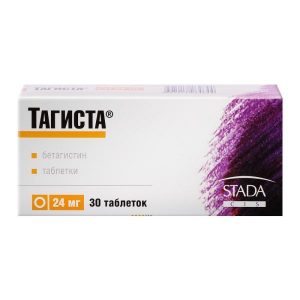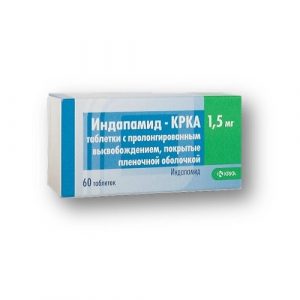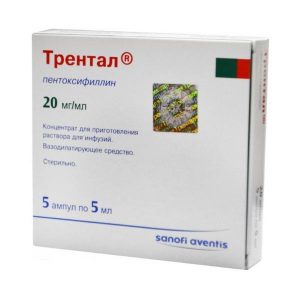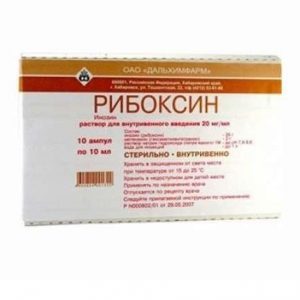Description
Description
Round biconvex tablets coated with a white film coating. Cross section shows the inner layer of a white or creamy-white color.
Indications
Arterial hypertension.
Contraindications
Hypersensitivity to indapamide, other sulfonamide derivatives or other components of the drug, acute cerebrovascular accident, severe renal impairment (creatinine clearance less than 30 ml / min) and / or liver (including hepatic encephalopathy) hypokalemia, pregnancy, lactation, age up to 18 years (efficacy and safety have not been established). These tablets contain lactose monohydrate (milk sugar), and therefore patients with rare hereditary diseases, such as lactose intolerance, lactase deficiency or glucose-galactose malabsorption, should not take the drug.
Caution. Use the drug with caution in diabetes mellitus, hyperuricemia (especially accompanied by gout and urate nephrolithiasis), hyponatremia and other disorders of water-electrolyte balance, moderate hepatic and / or renal failure, chronic heart failure, hyperparathyroidism, in patients with an extended QT interval on an ECG or receiving combination therapy, as a result of which an extension of the QT interval is possible (astemizole, erythromycin (intravenously), pentamidine, sultopride, terfenadine, vincamine (iv), antiarrhythmic drugs of class IA (quinidine, disopramide) and class III (amiodarone, bretilia tosylate).
Recommendations for use
Inside, without chewing, drinking plenty of fluids, regardless of food intake, mainly in the morning at a dose of 1.5 mg (1 tablet) per day. If the desired therapeutic effect is not achieved after 4-8 weeks of treatment, it is not recommended to increase the dose of the drug (the risk of side effects increases without increasing the antihypertensive effect). Instead, it is recommended that another antihypertensive drug that is not a diuretic be included in the drug regimen. In cases where treatment must be started with two drugs, the dose of Indapamide retard remains equal to 1.5 mg once a day in the morning. In elderly patients, the plasma concentration of creatinine should be controlled taking into account age, body weight and gender, the drug can be used in elderly patients with normal or slightly impaired renal function (see also section “Contraindications”).
Special instructions
Liver function impairment. Patients with hepatic insufficiency may develop hepatic encephalopathy when prescribing thiazide-like diuretics, especially if there is a violation of water-electrolyte balance. With its development, diuretics should be discontinued.
Photosensitivity. When using thiazide-like diuretics, cases of the development of photosensitivity reactions have been noted. If they develop, the drug should be discontinued. Against the background of therapy with Indapamide Retard, it is necessary to protect open areas of the body from exposure to sunlight and artificial ultraviolet radiation.
Water-electrolyte balance. The content of sodium ions in blood plasma: all diuretic drugs can cause hyponatremia. The content of sodium ions in blood plasma should be measured before starting treatment with Indapamide retard, and then regularly during the treatment period. Determination of the content of sodium ions in the blood plasma must be carried out before starting therapy with Indapamide retard, as well as during therapy. It is important to regularly monitor the content of sodium ions in blood plasma, because initially hyponatremia may be asymptomatic. The most careful control of the content of sodium ions is shown to elderly patients and patients with cirrhosis.
Potassium ion content in blood plasma: the greatest risk in the treatment of thiazide-like diuretics is hypokalemia. Particular attention in order to prevent hypokalemia (less than 3.4 mmol / l) must be given attention in the following cases: weakened patients and / or receiving other therapy (antiarrhythmic drugs and drugs that can extend the QT interval on the ECG), in old age, patients with cirrhosis, peripheral edema and ascites with coronary heart disease and chronic heart failure. Hypokalemia in such patients enhances the toxic effect of cardiac glycosides and increases the risk of arrhythmia. An increased risk group also includes patients with an extended QT interval on the ECG. Hypokalemia is a predisposing factor in the occurrence of severe arrhythmias, and especially pirouette type arrhythmias, which can be fatal. In all the cases described, it is necessary to regularly monitor the potassium content in the blood plasma. The first determination of potassium content in blood plasma should be carried out during the first week of therapy with Indapamide retard.
If hypokalemia is detected, appropriate therapy should be given.
Plasma calcium ion content: thiazide-like and thiazide diuretics can reduce the excretion of calcium ions by the kidneys, leading to minor and / or temporary hypercalcemia. Severe hypercalcemia while taking Indapamide Retard may be a consequence of previously undiagnosed hyperparathyroidism.
You should stop taking diuretics before examining the function of the parathyroid glands.
Plasma glucose concentration: in patients with diabetes mellitus, especially in the presence of hypokalemia, plasma glucose concentration control is necessary.
uric acid: in patients with hyperuricemia, it may increase the incidence of seizures or exacerbation of the course of gout.
Renal function and diuretic drugs. Thiazide and thiazide-like diuretics are fully effective only in patients with normal or slightly reduced (adult plasma creatinine less than 25 mg / L or 220 μmol / L) renal function. Severe hypovolemia can lead to acute renal failure (decrease in speed glomerular filtration), which may be accompanied by an increase in the concentration of urea and creatinine in blood plasma. With normal renal function, transient functional renal failure usually goes away without consequences. With existing renal failure, the patient’s condition may worsen.
Elderly patients. Regular monitoring of creatinine concentration and plasma potassium is recommended, taking into account the patient’s age, body weight and gender. Indapamide retard can be prescribed for elderly patients with preserved or slightly impaired renal function (CC above 30 ml / min).
Athletes. Indapamide retard can give a positive result when conducting a doping control.
Influence on the ability to drive vehicles and other complex mechanical means. The use of indapamide retard does not lead to a violation of psychomotor reactions. However, in some patients, in response to a decrease in blood pressure, various individual reactions may develop, especially at the beginning of therapy or when other antihypertensive agents are added to the therapy. In this regard, at the beginning of treatment with Indapamide Retard, it is not recommended to drive vehicles or other complex mechanisms that require increased attention.
Composition
One sustained-release tablet tablet contains:
as an active ingredient:
indapamide – 1.5 mg
excipients:
hypromellose – 77.36 mg,
lactose monohydrate (milk sugar) – 119.14 mg,
silicon dioxide colloidal (aerosil) – 1.0 mg,
magnesium stearate – 1.0 mg,
hypromellose – 2.24 mg ,
lactose monohydrate – 2.88 mg,
polyethylene glycol – 0.80 mg,
titanium dioxide – 2.08 mg.
Side effects
Most adverse reactions (laboratory and clinical indicators) are dose-dependent. The frequency of adverse reactions that can be caused by thiazide-like diuretics, including indapamide, shown as the following gradations: very often (> 1/10) often (> 1/100, <1/10) infrequently (> 1/1000, <1/100) rarely (> 1/10000, <1/1000) very rarely (<1/10000) of unspecified frequency (frequency cannot be calculated from available data). From the circulatory and lymphatic systems. Very rarely: thrombocytopenia, leukopenia, agranulocytosis, aplastic anemia, hemolytic anemia. From the central nervous system. Rarely: dizziness, fatigue, headache, paresthesia. From the cardiovascular system. Very rare: arrhythmia, lowering blood pressure. From the digestive system. Uncommon: vomiting. Rarely: nausea, constipation, dry mouth. Very rarely: pancreatitis. From the urinary system. Very rare: renal failure. On the part of the liver and biliary tract. Very rare: impaired liver function. Unspecified frequency: possibility of developing hepatic encephalopathy in case of liver failure. From the skin. Hypersensitivity reactions, mainly dermatological, in patients with a predisposition to allergic and asthmatic reactions: Often: maculopapular rash. Infrequently: hemorrhagic vasculitis. Very rarely: angioedema and / or urticaria, toxic epidermal necrolysis, Stevens-Johnson syndrome. Unspecified frequency: may worsen if there is an acute form of disseminated lupus erythematosus. Cases of photosensitivity are described. Laboratory indicators. In clinical studies, hypokalemia (plasma potassium content? 3.4 mmol / l) was observed in 10% of patients and 3, 2 mmol / l – in 4% of patients after 4-6 weeks of treatment. After 12 weeks of therapy, the level of potassium in the blood plasma decreased, on average, by 0.23 mmol / L. Very rarely hypercalcemia. Unspecified frequency: Hypokalemia Hyponatremia accompanied by hypovolemia, dehydration and orthostatic hypotension. The simultaneous loss of chlorine ions can lead to compensatory metabolic alkalosis, however, the frequency of development of alkalosis and its severity is not significant An increase in the level of uric acid and glucose in blood plasma. Drug interaction Not recommended combinations When used together with lithium preparations, it is possible to increase the concentration of lithium ions in the blood plasma due to a decrease in its excretion from the body by the kidneys, accompanied by the appearance of signs of overdose (nephrotoxic effect), as well as with a salt-free diet (decreased ion excretion lithium by the kidneys). Combinations requiring special attention. 1. Drugs that can cause a disturbance in the rhythm of the heart according to the “pirouette” type: antiarrhythmic drugs of class IA (quinidine, hydroquinidine, disopyramide), class III antiarrhythmic drugs (amiodarone, dofetilide, ibutilide, bretilia tosylate), sotalol, some antipsychotics: phenothiazines (chlorpromazine, cyamemazine, levomepromazine, thioridazine, trifluoperazide, aminosyridride, pyridopridepridepropide, with amisulapridepridepride , haloperidol), other (bepridil, cisapride, difemanil, erythromycin (intravenous (iv)), halofantrine, misolastine, pentamidine, sparfloxacin, moxifloxacin, vincamine (iv), astemizole. Simultaneous use with any of these drugs, oso enno on the background of hypokalemia increases the risk of ventricular arrhythmias of the type “pirouette” Before the beginning of combined therapy with indapamide retard, and the above-mentioned drugs should be monitored content of potassium in the blood plasma and, if necessary, correct it is recommended..: monitoring the clinical condition of the patient, as well as the content of electrolytes in blood plasma and ECG. In patients with hypokalemia, it is necessary to use drugs that do not provoke the development of pirouette type arrhythmias. 2. With the simultaneous administration of non-steroidal anti-inflammatory drugs (NSAIDs) (for systemic use), including selective cyclooxygenase-2 inhibitors (COX-2), high doses of salicylic acid (3 g / day or more), it is possible: a decrease in the antihypertensive effect of indapamide, development acute renal failure in dehydrated patients (due to a decrease in glomerular filtration rate). At the beginning of indapamide therapy, it is necessary to restore the water-electrolyte balance and monitor kidney function. 3. Angiotensin-converting enzyme (ACE) inhibitors in patients with hyponatremia (especially in patients with renal artery stenosis) increase the risk of hypotension and / or acute renal failure. Patients with arterial hypertension and possibly with hyponatremia due to diuretics should: – stop taking the drug 3 days before starting ACE inhibitor therapy and switch to potassium-sparing diuretics – or start therapy with ACE inhibitors at low doses, followed by a gradual increase in dose if necessary. In the first week of therapy with ACE inhibitors, it is recommended that plasma creatinine concentration be monitored. 4. Other drugs that can cause hypokalemia: – amphotericin B (iv), – gluco- and mineralocorticosteroids (for systemic use) (see also information in the section “Combinations of drugs requiring attention”), tetracosactide (see also information in the section “Combinations of drugs requiring attention”) – laxatives that stimulate intestinal motility. While taking the above drugs with indapamide, the risk of developing hypokalemia increases (additive effect). If necessary, you should monitor and adjust the content of potassium ions in the blood plasma. 5. Concomitant therapy with baclofen enhances the antihypertensive effect of indapamide. 6. Cardiac glycosides: hypokalemia increases the toxic effect of cardiac glycosides (glycoside intoxication). With the simultaneous use of indapamide and cardiac glycosides, the content of potassium ions in the blood plasma, ECG indicators, and, if necessary, should be monitored adjust therapy. Combinations of drugs requiring attention. 1. Concomitant use with potassium-sparing diuretics (amiloride, spironolactone, triamteren) is advisable in some patients, but the possibility of developing hypokalemia is not excluded. Against the background of diabetes mellitus or renal failure, the development of hyperkalemia is possible. It is necessary to control the content of potassium ions in the blood plasma, ECG indicators, and, if necessary, adjust the therapy. 2. Metformin increases the risk of lactic acidosis, because possible development of renal failure while taking diuretics, especially “loopback” ones. Metformin should not be taken at a plasma creatinine concentration of more than 15 mg / L (135 μmol / L) in men and 12 mg / L (110 μmol / L) in women. 3. The simultaneous use of large doses of iodine-containing contrast agents against the background of hypovolemia and the intake of diuretics increases the risk of acute renal failure. It is recommended to restore the water-electrolyte blood balance before using the drugs. 4. Tricyclic antidepressants (imipramine-like) and antipsychotics increase the hypotensive effect and the risk of developing orthostatic hypotension (additive effect). 5. Preparations containing calcium salts increase the risk of hypercalcemia due to decreased excretion of calcium ions by the kidneys. 6. Cyclosporin, tacrolimus – the risk of increasing creatinine concentration in blood plasma without changing the concentration of circulating cyclosporin. 7. Glucorticosteroid drugs, tetracosactide (with systemic use) reduce the antihypertensive effect (sodium and fluid retention). Overdose Symptoms: nausea, vomiting, weakness, impaired gastrointestinal function (nausea, vomiting), water-electrolyte disturbances, marked decrease in blood pressure, dizziness, drowsiness, confusion, respiratory depression, polyuria, oliguria , in patients with impaired liver function, the development of hepatic coma is possible. Treatment: gastric lavage and / or administration of activated charcoal followed by restoration of normal water-electrolyte balance, symptomatic therapy. There is no specific antidote. Storage conditions In a dry, dark place at a temperature of no higher than 25 C. Keep out of the reach of children. The Expiration of is 3 years. Do not use after the expiry date, specified on the package. Pharmacy Packages p14ffdff14 Pharmaceuticals p14ffff 37 Pharmaceutical Pharmaceutical Products Pharmaceutical Products from pharmacies Prescription Dosage form tablet prolong.




